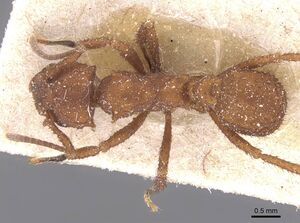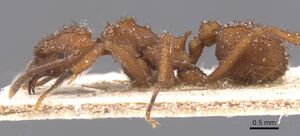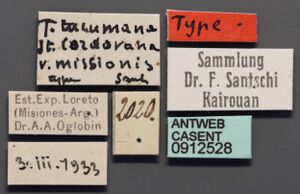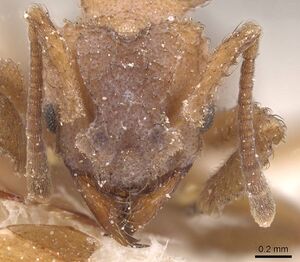Mycetomoellerius tucumanus
| Mycetomoellerius tucumanus | |
|---|---|

| |
| Scientific classification | |
| Kingdom: | Animalia |
| Phylum: | Arthropoda |
| Class: | Insecta |
| Order: | Hymenoptera |
| Family: | Formicidae |
| Subfamily: | Myrmicinae |
| Tribe: | Attini |
| Genus: | Mycetomoellerius |
| Species: | M. tucumanus |
| Binomial name | |
| Mycetomoellerius tucumanus (Forel, 1914) | |
| Synonyms | |
| |
Little is known about the biology of Mycetomoellerius tucumanus.
Identification
Mayhe-Nunes and Brandão (2005) - This species falls into same dichotomy with Mycetomoellerius holmgreni in the identification key. Besides differences pointed out in the discussion, M. tucumanus has a distinct shape of the antennal scapes lobes, without marked tip.
Except for the slight differences observed in the synonymized varieties, we did not observe any significant variation in the other studied specimens.
Keys including this Species
Distribution
Latitudinal Distribution Pattern
Latitudinal Range: -26.808285° to -34.583333°.
| North Temperate |
North Subtropical |
Tropical | South Subtropical |
South Temperate |
- Source: AntMaps
Distribution based on Regional Taxon Lists
Neotropical Region: Argentina (type locality), Uruguay.
Distribution based on AntMaps
Distribution based on AntWeb specimens
Check data from AntWeb
Countries Occupied
| Number of countries occupied by this species based on AntWiki Regional Taxon Lists. In general, fewer countries occupied indicates a narrower range, while more countries indicates a more widespread species. |

|
Estimated Abundance
| Relative abundance based on number of AntMaps records per species (this species within the purple bar). Fewer records (to the left) indicates a less abundant/encountered species while more records (to the right) indicates more abundant/encountered species. |

|
Biology
|
Castes
Images from AntWeb
   
| |
| Syntype of Acromyrmex iheringi cordovana. Worker. Specimen code casent0912527. Photographer Will Ericson, uploaded by California Academy of Sciences. | Owned by NHMB, Basel, Switzerland. |
   
| |
| Type of unavailable quadrinomial: Trachymyrmex tucumanus cordovanus missionensis. Worker. Specimen code casent0912528. Photographer Will Ericson, uploaded by California Academy of Sciences. | Owned by NHMB, Basel, Switzerland. |
   
| |
| Syntype of Mycetomoellerius tucumanus fracticornis. Worker. Specimen code casent0912529. Photographer Will Ericson, uploaded by California Academy of Sciences. | Owned by NHMB, Basel, Switzerland. |
   
| |
| Syntype of Mycetomoellerius tucumanus weiseri. Worker. Specimen code casent0912530. Photographer Will Ericson, uploaded by California Academy of Sciences. | Owned by NHMB, Basel, Switzerland. |
Nomenclature
The following information is derived from Barry Bolton's Online Catalogue of the Ants of the World.
- tucumanus. Acromyrmex (Trachymyrmex) iheringi var. tucumana Forel, 1914d: 282 (w.) ARGENTINA.
- Bruch, 1921: 202 (q.).
- Combination in Trachymyrmex: Gallardo, 1916d: 325.
- Combination in Mycetomoellerius: Solomon et al., 2019: 948.
- Status as species: Santschi, 1925e: 164.
- Senior synonym of cordovanus, fracticornis, weiseri: Mayhé-Nunes & Brandão, 2005: 299.
- cordovanus. Acromyrmex (Trachymyrmex) iheringi var. cordovana Bruch, 1921: 202 (w.) ARGENTINA. Combination in Trachymyrmex: Kempf, 1972a: 254. Subspecies of tucumanus: Santschi, 1922b: 358. Junior synonym of tucumanus: Mayhé-Nunes & Brandão, 2005: 299.
- fracticornis. Trachymyrmex tucumana var. fracticornis Santschi, 1925e: 164 (w.) ARGENTINA. Junior synonym of tucumanus: Mayhé-Nunes & Brandão, 2005: 299.
- weiseri. Trachymyrmex tucumana var. weiseri Santschi, 1925e: 164 (w.) ARGENTINA. Junior synonym of tucumanus: Mayhé-Nunes & Brandão, 2005: 299.
Unless otherwise noted the text for the remainder of this section is reported from the publication that includes the original description.
Description
Worker
Mayhe-Nunes and Brandão (2005) - TL 3.7-4.2; HL 1.14-1.26; HW 1.02-1.18; IFW 0.62-0.68; ScL 0.85-0.95; TrL 1.40-1.51; HfL 1.26-1.37. Ferruginous to yellowish brown, some specimens with darker gaster. Integument fine and indistinctly shagreened, opaque. Hairs moderately scarce on the body, short and erect or curved on appendages; hook-like mixed with oblique to decumbent hairs on other parts of body.
Head in full view as long as broad (CI 100). Mandible smooth and shining except laterally on base where it is finely transversely striate, and near the masticatory margin, which bears the apical and 6 regularly developed teeth. Frontal lobe sub-triangular, moderately expanded laterad (FLI 58), backwards directed and laterally subdentate; anterior and posterior borders weakly concave. Frontal carina diverging caudad, reaching the apex of scrobe. Front and vertex with small isolated piligerous tubercles. Posterior third of antennal scrobe clearly delimited by the frontal carina but weakly marked by the extension of the preocular ones. Supraocular proection formed by a group of small tubercles. Occiput notched in the middle. Occipital tooth developed as a stout spine-like projection rather microtuberculated. Inferior occipital corner indistinctly emarginated with weak carina. Eye moderately convex, no more than 12 facets in a row across the greatest diameter. Antennal scape weakly surpassing the occipital corner when laid back over head as much as possible; basal lobe transversely enlarged, its lateral projections moderately expanded to both sides; anterior surface surmounted by small tubercles.
Alitrunk. Pronotum with a marked humeral angle; antero-inferior corner armed with a triangular and flattened spine-like projection; lateral spines long; median projections as two small microscopic spines. First pair of mesonotal projections, although a little stouter, similar to pronotal lateral ones; second and third projections represented by two parallel and longitudinal rows of small tubercles. Mesopleura without hairs; blunt to acute triangular projection on superior border of katepisternum (rarely inconspicuous).
Alitrunk weakly constricted dorso-laterally al the shallowly impressed metanotal groove. Basal face of propodeum narrow, laterally delimited by a row of small teeth, sometimes inconspicuous; propodeal spines longer and slender than promesonotal projections.
Waist and gaster. Petiole shortly pedunculate, the node proper as long as broad, with one pair of dorsal bifid teeth; subpetiolar process vestigial. Postpetiole slightly broader than long, shallowly excavated above; postero-dorsal border straight; postero-lateral corners wilhoul projections. Gaster opaque with minute piligerous tubercles more or less distributed in four irregular longitudinal series on tergum I.
Type Material
Mayhe-Nunes and Brandão (2005) - worker: Argentina, Tucuman, Concepcion.
T. tucumana (type) XXI.V.d.3419 Argentina, Tucuman, Chipton col in Naturhistorisches Museum, Basel; not examined (Dietz personal communication). Obs. Collecters name is Shipton in original description.
Syntype workers of the varieites T. tucumanus var. fracticornis and T. tucumanaus var. weiseri in Museu de Zoologia da Universidade de Sao Paulo; examined.
References
- Bruch, C. 1921. Estudios mirmecológicos. Rev. Mus. La Plata 26: 175-211 (page 202, queen described)
- Forel, A. 1914d. Formicides d'Afrique et d'Amérique nouveaux ou peu connus. Bull. Soc. Vaudoise Sci. Nat. 50: 211-288 (page 282, worker described)
- Gallardo, A. 1916e. Notes systématiques et éthologiques sur les fourmis attines de la République Argentine. An. Mus. Nac. Hist. Nat. B. Aires 28: 317-344 (page 325, Combination in Trachymyrmex)
- Mayhé-Nunes, A. J. and Brandão, C. R. F. 2005. Revisionary studies on the attine ant genus Trachymyrmex Forel. Part 2: the Iheringi group (Hymenoptera: Formicidae). Sociobiology. 45(2):271-305. (page 299, figs. 37-40 worker described; senior synonym of cordovanus, fracticornis, and weiseri)
- Santschi, F. 1925e. Fourmis des provinces argentines de Santa Fe, Catamarca, Santa Cruz, Córdoba et Los Andes. Comun. Mus. Nac. Hist. Nat. "Bernardino Rivadavia" 2: 149-168 (page 164, raised to species)
- Solomon, S.E., Rabeling, C., Sosa-Calvo, J., Lopes, C.T., Rodrigues, A., Vasconcelos, H.L., Bacci Jr, M., Mueller, U.G., Schultz, T.R. 2019. The molecular phylogenetics of Trachymyrmex Forel ants and their fungal cultivars provide insights into the origin and coevolutionary history of ‘higher-attine’ ant agriculture. Systematic Entomology 44: 939-956 (doi:10.1111/syen.12370).
References based on Global Ant Biodiversity Informatics
- Brandao, C.R.F. 1991. Adendos ao catalogo abreviado das formigas da regiao neotropical (Hymenoptera: Formicidae). Rev. Bras. Entomol. 35: 319-412.
- Cuezzo, F. 1998. Formicidae. Chapter 42 in Morrone J.J., and S. Coscaron (dirs) Biodiversidad de artropodos argentinos: una perspectiva biotaxonomica Ediciones Sur, La Plata. Pages 452-462.
- Diehl-Fleig E. 2014. Termites and Ants from Rio Grande do Sul, Brazil. Sociobiology (in Press).
- Forel A. 1909. Ameisen aus Guatemala usw., Paraguay und Argentinien (Hym.). Deutsche Entomologische Zeitschrift 1909: 239-269.
- Gallardo A. 1916. Notes systématiques et éthologiques sur les fourmis attines de la République Argentine. Anales del Museo Nacional de Historia Natural de Buenos Aires 28: 317-344.
- Kempf, W.W. 1972. Catalago abreviado das formigas da regiao Neotropical (Hym. Formicidae) Studia Entomologica 15(1-4).
- Klingenberg, C. and C.R.F. Brandao. 2005. The type specimens of fungus growing ants, Attini (Hymenoptera, Formicidae, Myrmicinae) deposited in the Museu de Zoologia da Universidade de Sao Paulo, Brazil. Papeis Avulsos de Zoologia 45(4):41-50
- Kusnezov N. 1957. Die Solenopsidinen-Gattungen von Südamerika (Hymenoptera, Formicidae). Zoologischer Anzeiger 158: 266-280.
- Kusnezov N. 1978. Hormigas argentinas: clave para su identificación. Miscelánea. Instituto Miguel Lillo 61:1-147 + 28 pl.
- Kusnezov, N. "Lista de las hormigas de Tucumán con descripción de dos nuevos géneros (Hymenoptera, Formicidae)." Acta Zoologica Lilloana 13 (1953): 327-339.
- Mayhé-Nunes A. J., and C. R. F. Brandão. 2005. Revisionary studies on the attine ant genus Trachymyrmex Forel. Part 2: the Iheringi group (Hymenoptera: Formicidae). Sociobiology 45(2): 271-305.
- Santoandre S., J. Filloy, G. A. Zurita, and M. I. Bellocq. 2019. Ant taxonomic and functional diversity show differential response to plantation age in two contrasting biomes. Forest Ecology and Management 437: 304-313.
- Santschi F. 1925. Fourmis des provinces argentines de Santa Fe, Catamarca, Santa Cruz, Córdoba et Los Andes. Comunicaciones del Museo Nacional de Historia Natural "Bernardino Rivadavia" 2: 149-168.
- Santschi F. 1931. Contribution à l'étude des fourmis de l'Argentine. Anales de la Sociedad Cientifica Argentina. 112: 273-282.
- Vittar, F. 2008. Hormigas (Hymenoptera: Formicidae) de la Mesopotamia Argentina. INSUGEO Miscelania 17(2):447-466
- Vittar, F., and F. Cuezzo. "Hormigas (Hymenoptera: Formicidae) de la provincia de Santa Fe, Argentina." Revista de la Sociedad Entomológica Argentina (versión On-line ISSN 1851-7471) 67, no. 1-2 (2008).
- Zolessi L. C. de, Y. P. Abenante, and M. E. de Philippi. 1988. Lista sistematica de las especies de Formicidos del Uruguay. Comun. Zool. Mus. Hist. Nat. Montev. 11: 1-9.
- Zolessi L. C. de; Y. P. de Abenante, and M. E. Philippi. 1989. Catálogo sistemático de las especies de Formícidos del Uruguay (Hymenoptera: Formicidae). Montevideo: ORCYT Unesco, 40 + ix pp.
- de Zolessi, L.C., Y.P. de Abenante and M.E. Philippi. 1987. Lista sistemática de las especies de formícidos del Uruguay. Comunicaciones Zoologicas del Museo de Historia Natural de Montevideo 11(165):1-9

